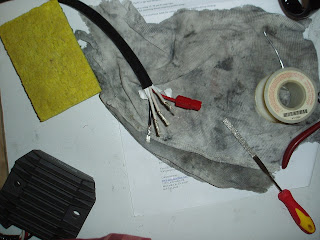November 13, 2015
The FZ1 has been having ongoing charging system issues. Went out the first time on the way to work late at night in August. First the speedo & tach went dead so I knew something was wrong. Then a few miles later the dash went out, then the lights, finally coasted to work with the engine barely running. Still had to work all night of course, then figure out how to get home.
So I bought a new OEM battery from
Mach1 Motorsports, brought it to work the next day, swapped it out in the parking lot, and was able to make it home on battery power only.
Over the weekend I was able to do some charging system troubleshooting using my trusty Harbor Freight multi-meter and an
electrical system troubleshooting flowchart from electrosport.com. So I found the alternator was putting our 18VAC, the battery of course was new, and I was never sure of the readings I was getting from the regulator/rectifier. So I replaced it ($135 OEM at motosport.com).
So the bike ran fine for a few months, then on the way home from work Friday the 13th the dash started looking a bit dim. I thought maybe it was my night vision. Then closer to home the needles started bouncing--sure sign of trouble. Finally as I pulled into the driveway I hit the high beams and the dash went out, so I knew the charging system was dead again.
Not having another 2 hours to spend with my multi-meter and the flowchart, I called Mach1 and tried to make an appointment for charging system diagnosis. They asked the year of the bike, so I told them '03, and they said they didn't really like working on stuff that old. I was like, "really?" They asked some questions about the condition of the bike, whether it was a basket case, etc. and I finally said, let me just bring it by, and if it looks like something you don't want to deal with I'll take it home. Their first available appointment was 2 weeks out so I scheduled it, feeling like I didn't have much of a choice.
There is a lot of editorial comment I could make here about the state of motorcycle repair shops, how they're only interested in selling new bikes and turning around the easiest jobs to make the most profit possible. I wouldn't think any reputable auto mechanic would turn away a 12-year-old car with 79k miles. But that is another topic.
Now the bike had been sitting idle in the garage all this time, and I started feeling bad, so I decided the least I could do would be to look for bad wires or loose connections. So I propped up the tank and disconnected the regulator, and found my bike had succumbed to the infamous white connector problem:
The white connector is a known source of issues in 1st gen FZ1s. It's bitten enough FZ1 owners that there is a
connector fix on the FZ1 owner's list, but unfortunately the author, Eskort, didn't list what type of connectors he used as replacements. So I sent him a forum PM, heard nothing for a few days, then emailed him via the forum. He responded a day later with a
link to a pack of Anderson Powerpole 15 amp connectors ($7.50 + $4.49 shipping). So I canceled my shop appointment. They were polite about it.
I also bought a
crimper ($38 on amazon), which I wasn't sure if I'd need but seemed like a good thing to have. Finally, another OEM regulator/rectifier from MotoSport ($135), noting also that Rick's Motorsports sells an
aftermarket regulator/rectifier for slightly cheaper (around $90). Maybe next time.
Hopefully for slightly under $200 I'll have the charging system fixed once and for all. Will write up the mechanical work once I get the parts (early December).















































